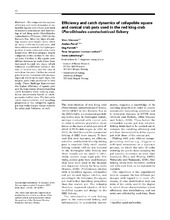Efficiency and catch dynamics of collapsible square and conical crab pots used in the red king crab (Paralithodes camtschaticus) fishery
Peer reviewed, Journal article
Published version

Åpne
Permanent lenke
http://hdl.handle.net/1956/12144Utgivelsesdato
2008Metadata
Vis full innførselSamlinger
Sammendrag
We compared the capture efficiency and catch dynamics of collapsible square and conical pots used in resource assessment and harvesting of red king crabs (Paralithodes camtschaticus [Tilesius, 1815]) in the Barents Sea. After two days of soaking, square pots caught three times as many crabs as conical pots, and their catches consisted of a higher proportion of male crabs and male crabs larger than 160 mm carapace length compared to the catches in the conical pots. Catches in the square pots did not increase as soak times were increased beyond two days, which indicates equilibrium between the rate of entries into and the rate of exits from the pots. Catches in conical pots, however, increased with increasing soak times up to eight days, the longest soak time examined in this study. These findings demonstrate the higher efficiency of square pots and the importance of understanding catch dynamics when making population assessments based on catchper-unit-of-effort data. The favorable catch characteristics and handling properties of the collapsible square pot may make this pot design suitable for other crab fisheries, as well.